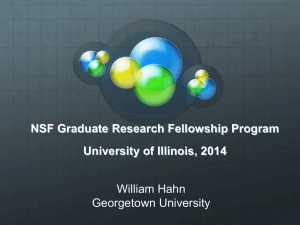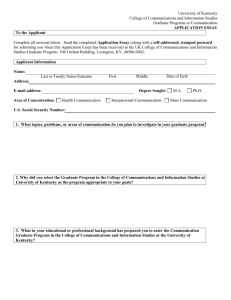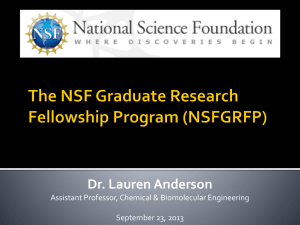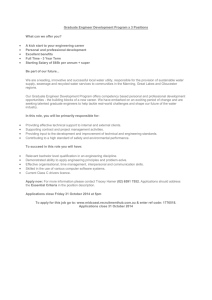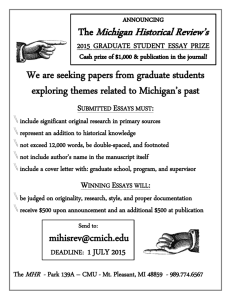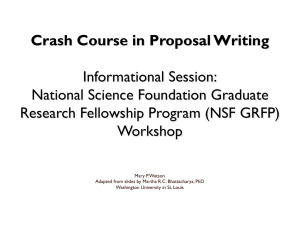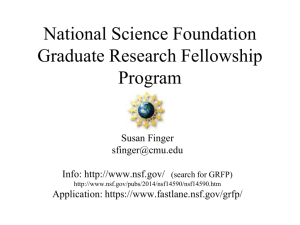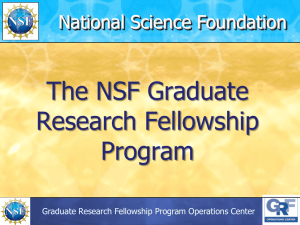Presentation - North Carolina State University
advertisement
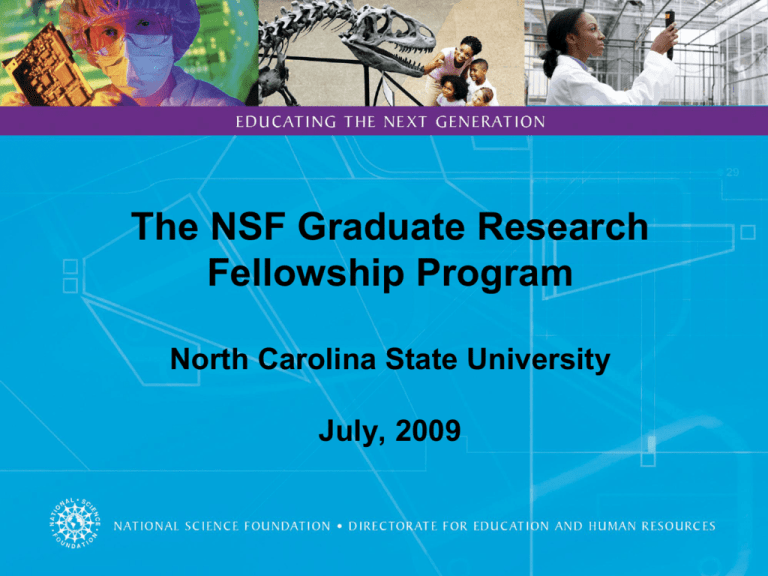
The NSF Graduate Research Fellowship Program North Carolina State University July, 2009 Congress of the United States Office of Management and Budget President of the United States Supreme Court of the US Science Advisor Office of Science and Technology Policy Other Boards and Oversight Committees Major Departments Agriculture Energy Commerce Homeland Security Health and Human Services Independent Agencies National Science Foundation Environmental Protection Agency Smithsonian Institution NASA Defense Inspector General National Science Board Director Deputy Director Biological Sciences Mathematical & Physical Sciences Computer & Info. Science & Engineering Staff Offices International S&E Cyberinfrastructure Integrative Activities Engineering Social, Behavioral, and Economic Sciences Geosciences Education and Human Resources The National Science Foundation Federal agency created in 1950 to “to promote the progress of science; to advance the national health, prosperity, and welfare; to secure the national defense” >$6 billion annual budget for research and education in Science, Technology, Engineering and Math (STEM) disciplines - all fields but clinical biomedical (NIH) Annually awards about 10,000 research grants, 2800 graduate fellowships (direct to student), 1500 graduate trainees (e.g., IGERT, GK-12), and 30,000 graduate research assistantships (via grants to Principal Investigators) NSF Graduate Research Fellowship Initiated in 1952 – oldest NSF program >44,000 students including FY2009 awards Currently ca. 3500 fellows, ca. 2800 on “tenure” (taking stipend and cost of education) Very successful students - high rates of PhD completion, shorter time to degree completion, high placement in faculty positions, high levels of research productivity, >20 Nobel laureates, etc. The NSF Graduate Research Fellowship Three years of support over a five year period Annual stipend of $30,000 - cost of living Tuition support of $10,500 - cost of education allowance paid to institution - remainder normally covered by university $1,000 one-time international travel allowance Cyberinfrastructure access via the TeraGrid The NSF Graduate Research Fellowship Portable to graduate institutions in US or abroad Flexible - your choice of project, advisor, department No service requirement (national lab or military) Typically awarded to ca. 1,000 students per year – but poised for tripling over the next few years Honorable Mention for meritorious applications (includes Cyberinfrastructure resources) Specific programs to support underrepresented populations GRF Eligibility Criteria Academic level Level 1 - Seniors, baccalaureates with no graduate study Level 2 - First-year graduate students Level 3 - Second-year grad students (12 months of graduate study or less by Aug 31 prior to submission) Level 4 - >12 months graduate study - change in field Citizenship U.S. Citizen, National or Permanent Resident Discipline Research-based Masters or PhD in NSF-Supported Field NSF-Supported Disciplines Chemistry Computer and Information Science and Engineering Engineering Geosciences Life Sciences Mathematical Sciences Physics and Astronomy Psychology (non-clinical) Social Sciences (non-clinical) Some Areas Not Supported by the GRF Clinical work Counseling Business Management Social work Practice-oriented professional degree programs Joint science-professional degree programs (MD/PhD and JD/PhD) Medical, dental, law, or public health programs Changes in Disciplinary Distribution 100% Mathematics Computer Science 80% Physics Geoscience 60% Chemistry Engineering 40% Life Science 20% Social Science Psychology 19 52 19 55 19 58 19 61 19 64 19 67 19 70 19 73 19 76 19 79 19 82 19 85 19 88 19 91 19 94 19 97 20 00 20 03 0% Intellectual Merit Criterion How important is the proposed activity to advancing knowledge and understanding within its own field or across different fields? How well qualified is the proposer (individual or team) to conduct the project? (If appropriate, the reviewer will comment on the quality of prior work.) To what extent does the proposed activity suggest and explore creative, original, or potentially transformative concepts? How well conceived and organized is the proposed activity? Is there sufficient access to resources? Academic performance & background (grades, curricula, GRE) Awards/honors Communication skills Research experience International experience Independence/creativity Publications/presentations Research plan Choice of institution References Broader Impacts Criterion How well does the activity advance discovery and understanding while promoting teaching, training, and learning? How well does the proposed activity broaden the participation of underrepresented groups (e.g., gender, ethnicity, disability, geographic, etc.)? To what extent will it enhance the infrastructure for research and education, such as facilities, instrumentation, networks, and partnerships? Will the results be disseminated broadly to enhance scientific and technological understanding? What may be the benefits of the proposed activity to society? Prior accomplishments Community outreach Impact on society and connectivity Future plans Leadership potential Individual experiences Integration of research and education Potential to communicate to diverse audiences Application Materials - GRFP FastLane Personal Statement Essay (2 pgs incl figs) Previous Research Experience Essay (2 pgs incl figs) Proposed Plan of Research Essay (2 pgs incl figs) Completed Graduate Study Essay (For Level 4) Three Letters of Reference Transcripts GRE Scores (Optional but Highly Recommended) Personal Essay Two pages––often the hardest thing to write Make certain to discuss: Your motivation for research and particular choice of field Examples of leadership skills and unique characteristics you bring (avoid arrogance) Examples of personal and individual strengths you have that make you a qualified individual How the GRFP will assist you with career goals Provides opportunity for evaluators to see you as a person Opportunity to respond to broader impact merit criterion Previous Research Experience Essay Emphasize experience relevant to your proposal but include all examples of “research”, even if not in field List for each experience what were the hypothesis formulation and testing, experimental design, data management and analysis, interpretation of results, dissemination of findings Highlight what you did (independence) but discuss collaborators (teamwork) and leadership List any publications, posters, presentations, prizes, awards, grants, special recognition, etc. Proposed Research Essay Introduce general theory or area of study and importance - a few references will demonstrate your understanding of field Describe your motivation to go into that area Discuss your plans to prepare yourself for that field of study mention school(s), degree programs, potential advisor, etc. Spell out specific details of your research and study plan but avoid jargon, specific experimental details, etc. Comment on the broader impacts of your activities Let the reader know of your career plans, even if tentative Demonstrate flexibility (“plan B”) Letters of Reference Three required - should know you as scientist and person Will compare you with NSF Graduate Research Fellows & other successful students they have known based on: potential to make unique contributions to discipline; ability to conduct original research; leadership potential; productive member of scientific community; originality of plan of study Will state their role in assisting with the application Provide referees sufficient time; share application materials with them; ask for advice Track letters on FastLane - remind referees about deadline Panel Review of Applications Evaluated by Level but no limits on numbers from each Level. Long term success: Level 1>Level 2>Level 3>Level 4. Panelists are experts in general field, but may not be experts in your specific research specialty - avoid jargon Evaluated by 2 panelists, additional review for higher ranked applications - scored, then ranked by average of scores Panelists complete rating sheet regarding intellectual merit and broader impacts criteria highlighting strengths and areas for improvement - provided to eligible applicants NSF uses ranking and other factors (e.g., URM) to determine awardees and recipients of honorable mention Contact Information NSF GRF description, solicitation (08-593), and links: http://www.nsf.gov/grfp/ Online Application, User Guides, and Official Announcements: http://www.fastlane.nsf.gov/grfp/ Operations Center, Outreach, Helpdesk: http://www.nsfgrfp.org 866-NSF-GRFP (673-4737) help@nsfgrfp.org
